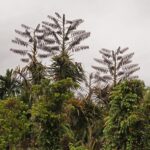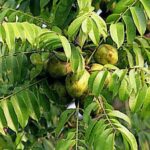Tok Pisin: Tu lip; Scientific name: Gnetum gnemon
What does a tu-lip tree look like?
It is a small tree often only 8-10 metres high. It is a fairly straight tree with one trunk that has branches spread out along its length. The branches are not very long so that the tree does not spread out very wide.
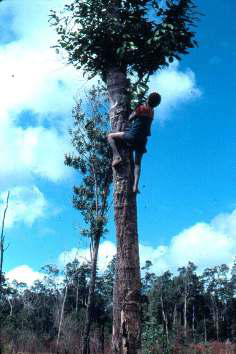

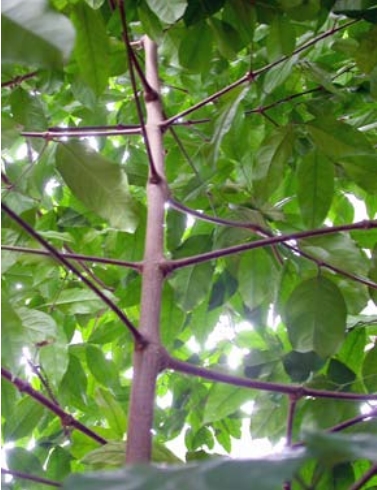
The tu-lip tree
In Tok Pisin this small tree is called tu-lip. As people in Holland and other countries grow a flower called tulip, we need to point out that the two plants, or their names have nothing in common. The “tu-lip” tree has no common English name although in some countries it is called jointfir. Scientists use the Latin name of Gnetum gnemon. This name was given to it by a famous botanist called Linnaeus more than 200 years ago.
People in Papua New Guinea call it “tu lip” because of the way the leaves are arranged. It has two leaves (tu lip) opposite each other along the branches. Often the branches also come out in pairs opposite each other. The fresh young leaves have a slightly brownish green colour and are in pairs. The older leaves are dark green and shiny.


When the tree has fruit it can be covered with green nut-like fruit that turn red when ripe.


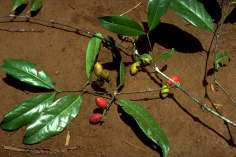
The male and female flowers are separate and are on different trees. So only female trees bear fruit. The flowers are grouped on spikes that develop near the base of the leaves. The flowers are yellow.
This tree in common with some other closely related plants that are called Gnetum has rings or hoops at the places where the leaves occur. These can be seen in this picture.


A tu-lip tree has ridges running across the trunk that can help you recognise the tree
Why is the tu-lip tree so useful?
The young leaves of the tree are eaten and are a very popular green vegetable. They are very good quality food. They have been described as one of God’s good gifts to Papua New Guinea.
- The nut like fruit and seeds can be eaten. They are also very good food value.
- The bark of the tree is good for making ropes and nets.
- The timber can be burnt green, as firewood.
- The timber will last for a long time when used for posts in wharves in fresh water.
Where does the tu lip tree occur?

It grows wild in lowland and lower mountain regions of Papua New Guinea. People in these areas look after it and leave it growing when they are clearing new gardens in the rainforest. They often transplant seedling trees into their gardens and they also grow their own trees from seed.
But the tu-lip tree is common in a number of other Asian and Pacific Island countries. Another famous botanist called Rumphius spent many years in Asia. In the year 1670 he commented on the tu-lip tree in his notebook. The picture and his comments are reproduced here.
Tu-lip in the Southern Highlands Province
Tu-lip is an important and popular edible green in the lower areas of the Southern Highlands Province. Some of the names for it in the languages of these lowland groups of people are:-

Tu-lip grows from sea level up to about 1000m altitude. These areas for the Southern Highlands Province are shown on the map.

It is not equally important in all these areas. At Erave people harvest it out of the bush where trees grow naturally. But they don’t use it a lot. At Podopa villages, like Woposali and Boro and Foi villages such as Hegiso, trees are grown in and around the villages. People in these areas recognise and have names for 3 or 4 different varieties. Near Bosavi, the Kaluli people mainly harvest leaves and seeds from wild trees. Although trees are rarely planted the self-sown trees are protected when clearing bush for gardens and they are look after in gardens.
What is the food value of tu-lip?
In 100 grams of the part you eat the following amounts of different kinds of food occur.

This means that the leaves are very good quality food. The fruit and seeds are also very good quality food. If you eat a nice big bowl of these leaves they will provide a lot of your bodybuilding and your health food needs.
How do you prepare the food?
- The young tender leaves are picked and boiled or fried.
- The red fruits that are about 2.5 cm long can be eaten raw but they are tough.
- The seeds of the ripe fruits are eaten roasted, boiled or fried. Before cooking the seeds it is necessary to either remove the tip or crush the seed, or seeds can explode on heating.
- The young flowers including the young fruits are sometimes cooked and eaten.
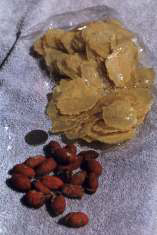
The leaves of very small seedling tu-lip trees in the rainforest are harvested of their young leaves as people walk past. So an early harvest can be gained. Like many tropical trees, tu-lip trees grow by producing flushes of new leaves throughout the year. So leaves are not always equally available. In fact many tu-lip trees have fresh young leaves for picking at one main season of the year.
Because the parts eaten can contain irritating substances the various parts are normally cooked before being eaten.
How do you grow tu-lip trees?
Tu-lip trees often grow wild. You can find a small wild plant in the bush and transplant it to where you want it.
You can also grow trees from seed. Collect a very ripe red fruit from a tree. It has one seed inside. If you simply plant it the seed sometimes takes a long time to start growing. You may have to wait 6 months. This is because the seeds have a hard outside layer and it is difficult for moisture to get in to start the seed growing. To get the seed to start growing more quickly you can carefully file a small hole through the outside layer of the seed.
If you are going to plant several trees they should be planted about 6 m apart. Because this tree grows naturally under larger trees in the rainforest it is suited to growing in places where there is some shade. Therefore you can plant the tree in a partly shaded place if you want to.
If you want to, you can grow trees from cuttings. This means you take a small branch off a tree and plant it in warm moist soil where it will develop roots and grow.
Pests and diseases
Tu-lip insect pests
- Eucalymnatus tessellatus (Signoret) Coccidae (HEM) soft scale
- Milviscutulus mangiferae (Green) Coccidae (HEM) soft scale
Probably the insect pests of tu-lip have not been properly studied.
________________________________________________________________________________________________________________
Text and all photos (except 2 photos clearly marked) at this article © Food Plant Solutions. The professional background and contact information of the author of this article can be found here.
.



